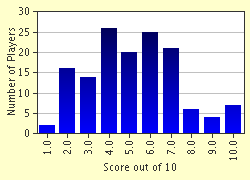Quiz Answer Key and Fun Facts
1. Phyllo dough, the impossibly thin pastry used frequently in Greek cooking, derives its name from the word "phullon". What is the English translation of the term?
2. In myth, when Athena was challenged by Poseidon to give the Greeks the most useful gift, she gave them the olive tree. She seems to have chosen well, considering the average adult in Greece uses up to 15 gallons of olive oil annually (and not just for eating!). 14% of the cultivated land in Greece is dominated by olive groves, with some 127,000 evergreen trees producing these delectable little fruits. Over 100 types of olive are produced worldwide. Which of these is not a Greek variety?
3. An interesting facet of Turkish cooking is the colorful names for certain dishes, including the "Swooning Imam" and the "Sultan's Delight". A number of foods are named after parts of the female anatomy as well. Which of these is not a real dish?
4. Typical mezzes, or appetizers, in Lebanon might include tabbouleh (bulgur and parsley salad), kibbeh (bulgur and lamb pâté), and labneh makbus (yogurt cheese balls). However, flat bread is perhaps the most important item at any meal. It is often served with za'atar, a combination of sumac, sesame seeds, oregano, salt, and which other herb?
5. Which of these would you pour over a cooled pan of baklawa?
6. In Saudi Arabia and various other Arab countries, a dish called "khouzi" is prepared. Khouzi consists of a whole lamb, including the head, stuffed with a chicken that has been packed with a combination of rice, onions, nuts, and golden raisins, all oven-baked until the meat falls away from the bone. The host of this feast serves the most succulent bits of meat to the main guest. Which portion of the lamb is most highly regarded?
7. In Greece, this liqueur is known as "ouzo" or "mistra." In Turkey, it is "raki," and in Lebanon it is "arak." When combined with water or poured over ice, it turns a milky white. It is often served alongside a stunning array of mezzes. Despite the variance in names, this beverage is always made from the same principal ingredient. What flavor is this apéritif?
8. The chickpea, known in various countries as the garbanzo bean, shimbra, or lablabi, is very high in protein and carbohydrates. Almost 90% of the world's chickpea supply comes from India, but it can also be grown in the Midwest United States. These beige, heart-shaped legumes are used in countless Middle Eastern dishes. Which of these does not contain chickpeas?
9. Which of these is not a spicy relish or sauce?
10. Finally, a simple question. What is "ghee"?
Source: Author
napkintosh
This quiz was reviewed by FunTrivia editor
Bruyere before going online.
Any errors found in FunTrivia content are routinely corrected through our feedback system.


